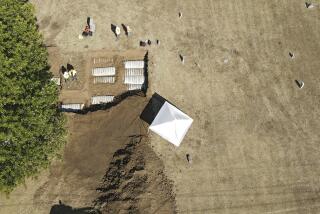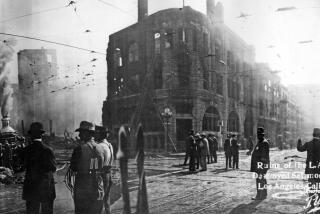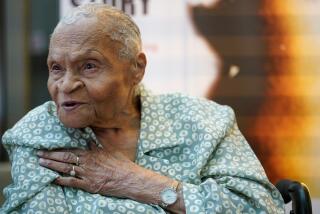‘Watchmen’ revived it. But the history of the 1921 Tulsa race massacre was nearly lost
The explosive opening in the first episode of HBO’s “Watchmen,” with citizens of a black Tulsa, Okla., neighborhood being gunned down by white vigilantes, black businesses deliberately burned and even aerial attacks, has brought new attention to the nearly buried history of what the Oklahoma Historical Society calls “the single worst incident of racial violence in American history.”
Though it looked like something made up for the series inspired by Alan Moore’s original “Watchmen” stories for DC Comics, the Tulsa race massacre of 1921 was an all too real incident that decimated 35 city blocks, including the business district of Tulsa’s Greenwood community, which Booker T. Washington once called the “Black Wall Street of America.” The official death toll was 36, but more recent estimates say that as many as 300 may have been killed; 800 were treated for injuries and more than 6,000 black citizens were interned at the city’s convention hall and fairgrounds for up to eight days. A search for mass graves has been undertaken in recent years.
HBO’s “Watchmen,” from “Lost” creator Damon Lindelof and starring Regina King, has been overrated, say Times critics Lorraine Ali and Robert Lloyd.
The incident began with an encounter between 19-year-old Dick Rowland, a black shoeshiner, and elevator operator Sarah Page, who by some accounts was as young as 15. For reasons that are still unknown, Page screamed when Rowland entered the elevator. Police were called and Rowland was arrested for attacking Page, though later accounts say Rowland may have simply tripped and fell onto Page. An inflammatory newspaper account stirred up the white community and crowds gathered outside the courthouse. With thoughts of protecting Rowland from lynching, members of the black community also appeared but were outnumbered and after fights broke out retreated to the city’s Greenwood neighborhood, where most black businesses and homes were located. The mob followed, and the massacre began in full force, aided by members of the Ku Klux Klan.
“Vigilantes ... under the color of law, destroyed the Black Wall Street of America,” said former state Rep. Don Ross in the 2001 “Tulsa Race Riot: A Report by the Oklahoma Commission to Study the Race Riot of 1921.” “Some known victims were in unmarked graves in a city-owned cemetery and others were hauled off to unknown places in full view of the National Guard.
HBO’s “Watchmen” examines race, white supremacy and police brutality. Sunday night’s series premiere has creator Damon Lindelof asking, “Should we have done it?”
In the aftermath of the killings, attempts were made to cover up the events. Stories were removed from newspaper archives, and some official accounts were destroyed. It took decades for historians and Oklahoma officials to unearth the history and begin to teach it in schools. But the years of silence took a toll on the truth — and even on how to label the incident. Many, for instance, question whether to call the events a “riot” or “massacre.” “Designating it a riot prevented insurance companies from having to pay benefits to the people of Greenwood whose homes and businesses were destroyed,” said a report by the Tulsa Historical Society and Museum.
High school history teacher Seymour Williams, explaining why there was largely silence in the black community following the violence, told Ross: “Blacks lost everything. They were afraid it could happen again, and there was no way to tell the story. The two Negro newspapers were bombed. ... [People] were too busy just trying to make it. ... The killers were still running loose, and they’re wearing blue suits as well as Klan sheets.”
For more reading on the Tulsa race massacre:
The overdue state report: Many credit journalist-turned-politician Don Ross with bringing attention to the events of 1921. He wrote three Oklahoma Eagle columns in 1968 about the riot and in 1971 published an account of the violence in an issue of Impact magazine, where he was then the editor. “Both blacks and whites got on my case for causing trouble,” he told the Kansas City Star in 1999. “I had violated the conspiracy of silence going on for 50 years.”
Ross went on to become an Oklahoma state representative and was on the commission that in 2001, 80 years after the destruction of America’s “Black Wall Street,” produced “Tulsa Race Riot: A Report by the Oklahoma Commission to Study the Tulsa Race Riot of 1921.” It includes a discussion of the disputed death toll, the use of airplanes to drop bombs on civilians, and the still unresolved issue of reparations.
The nearly forgotten initial Red Cross report: The Tulsa Historical Society and Museum has a section of its website devoted to the Tulsa race massacre. Among its archives are audio recordings of survivors, photos and one of the first historical documents on the violence, a Red Cross report issued December 30, 1921, by Maurice Williams, the director of relief operations in the area of destruction. “Disaster Relief Report: Riot 1921” begins with a clipping of the Tulsa Daily World article blaming the “battle between the races” on the arrest of shoeshiner Dick Rowland. Williams, however, writes, “The consensus of opinion, after six months intervening time, places the blame upon ‘the lack of law enforcement.’ ‘Race riot’ it has generally been termed, yet whites were killed and wounded by whites in the protection of white property against the violence of the white mob. The elements of ‘race rioting’ were present from all evidence ... but the wholesale destruction of property, life and limb in that section of the city occupied by [blacks] ... testifies to a one-sided battle.”
The eyewitness: “I could see planes circling in mid-air. They grew in number and hummed, darted and dipped low. I could hear something like hail falling upon the top of my office building. Down East Archer, I saw the old Mid-Way hotel on fire, burning from its top, and then another and another and another building began to burn from their top.” These are the words of Oklahoma lawyer Buck Colbert Franklin, from a 10-page typewritten manuscript that was discovered in 2015 and donated to the Smithsonian National Museum of African American History and Culture. Smithsonian magazine details the story and excerpts parts of the account: “The side-walks were literally covered with burning turpentine balls. I knew all too well where they came from, and I knew all too well why every burning building first caught from the top. I paused and waited for an opportune time to escape. ‘Where oh where is our splendid fire department with its half dozen stations?’ I asked myself. ‘Is the city in conspiracy with the mob?’”
More to Read
The biggest entertainment stories
Get our big stories about Hollywood, film, television, music, arts, culture and more right in your inbox as soon as they publish.
You may occasionally receive promotional content from the Los Angeles Times.











